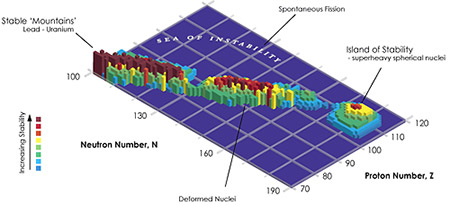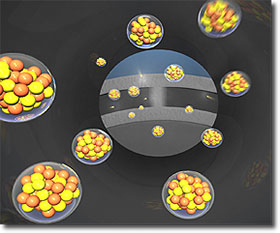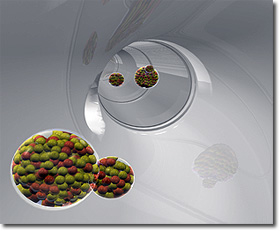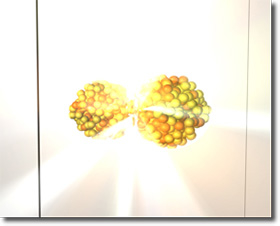Scientists from the Physical and Life Sciences Directorate at Lawrence Livermore National Laboratory, in collaboration with researchers from Dubna, the Joint Institute for Nuclear Research (JINR) in Russia, have discovered the newest superheavy element, element 118.
In experiments conducted at the JINR U400 cyclotron between February and June 2005, the researchers observed atomic decay patterns, or chains, that establish the existence of element 118. In these decay chains, previously observed element 116 is produced via the alpha decay of element 118.
The results are published in the October 2006 edition of the journal Physical Review C.
The experiment produced three atoms of element 118 when calcium ions bombarded a californium target. The team then observed the alpha decay from element 118 to element 116 and then to element 114. The Livermore-Dubna team had created the same isotope of element 116 in earlier experiments.
This discovery brings the total to five new elements for the Livermore-Dubna collaboration (113, 114, 115, 116 and 118).
“The decay properties of all the isotopes that we have made so far paint the picture of a large, sort of flat ‘Island of Stability’ and indicate that we may have luck if we try to go even heavier,” said Ken Moody, Livermore’s team leader.
The “Island of Stability” is a term from nuclear physics that describes the possibility of elements which have particularly stable “magic numbers” of protons and neutrons. This would allow certain isotopes of some transuranic elements (elements with atomic numbers greater than 92) to be far more stable than others, and thus decay much more slowly.
Element 118 is expected to be a noble gas that lies right below radon on the periodic table of elements.
“The world is made up of about 90 elements,” Moody said. “Anything more you can learn about the periodic table is exciting. It can tell us why the world is here and what it is made of.”
Members of the Livermore team include: Moody, Dawn Shaughnessy, Mark Stoyer, Nancy Stoyer, Philip Wilk, Jacqueline Kenneally, Jerry Landrum, John Wild, Ron Lougheed and former LLNL employee Joshua Patin.

A three-dimensional representation of the theoretical Island of Stability.
As for the future, the LLNL-Dubna team will continue to map the region near the “Island of Stability.” In 2007, the team plans to look for element 120 by bombarding a plutonium target with iron isotopes.
“The heavy element community will continue to search for new elements until the limit of nuclear stability is found,” Mark Stoyer said. “It is expected that limit will be found.”
Related Web Pages
- Livermorium
- Discovery of Elements 113-118
- Discovery of Elements 113 and 115
- Discovery of Elements 114 and 116
Contact: Dawn Shaughnessy [bio], shaughnessy2 [at] llnl.gov (shaughnessy2[at]llnl[dot]gov)



Art credit: Sabrina Fletcher and Thomas Tegge/LLNL
Artist’s conception of calcium ions traveling down the accelerator at a high velocity toward the rotating californium target. The new element 118 travels through the accelerator to the detector. The particle begins to decay and eventually fissions. Click on the images to download high-resolution versions.




